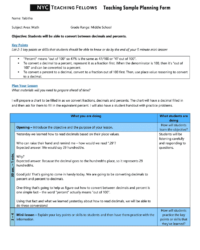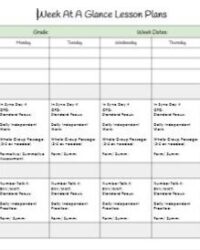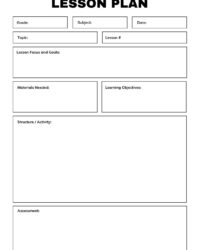Teaching math can sometimes feel like an uphill battle, especially when you’re trying to keep every student engaged and ensure they truly grasp the concepts. It’s not just about crunching numbers; it’s about building foundational understanding, critical thinking, and a love for problem-solving. We all want our students to walk away from a math lesson feeling confident and capable, not confused or frustrated.
That’s where a structured approach can make all the difference. Imagine a framework that guides you through every step of a lesson, from preparing students’ minds to consolidating their learning. This kind of systematic planning can transform your classroom experience, making lessons more effective, purposeful, and, dare we say, even fun. It empowers teachers to create a dynamic learning environment where every minute counts, ensuring students are not just passive recipients but active participants in their mathematical journey.
Unpacking the Power of a Structured Math Lesson
Adopting a "before during after" framework for your math lessons isn’t just a trend; it’s a pedagogical approach rooted in how students learn best. This model ensures that every phase of the lesson is intentionally designed to support understanding, application, and retention. It moves beyond simply presenting information to actively engaging students in a cycle of preparation, exploration, and reflection. Think of it as a roadmap that guides both you and your students through complex mathematical terrain, making sure no one gets lost along the way. This comprehensive structure helps to scaffold learning, making new concepts more accessible and building upon prior knowledge in a meaningful way.
The “Before” Phase: Setting the Stage for Learning
This initial phase is all about preparing the student’s mind for new material. It’s crucial for activating prior knowledge and making connections to what they already know. When students can link new information to existing mental frameworks, learning becomes more robust and less isolated. This also helps to build anticipation and curiosity, making them more receptive to the upcoming lesson. A well-executed "before" phase ensures students aren’t starting from a blank slate, but rather from a foundation of existing understanding, however rudimentary.
- Activating Prior Knowledge: Ask questions that recall relevant previous lessons or real-world experiences related to the topic.
- Setting Clear Objectives: Clearly state what students will learn and be able to do by the end of the lesson. This provides purpose.
- Building Engagement: Use a quick riddle, a relevant story, or a thought-provoking problem to pique interest.
- Vocabulary Preview: Introduce and discuss key mathematical terms students will encounter.
The “During” Phase: The Heart of the Lesson
The "during" phase is where the core instruction and active learning happen. This is not just about lecturing; it’s about guiding students through exploration, problem-solving, and collaborative activities. It’s the time for direct instruction, but also for students to grapple with new concepts, practice skills, and construct their own understanding. Effective "during" activities encourage participation, critical thinking, and different approaches to solving problems. This is where the real "heavy lifting" of learning takes place, often involving hands-on activities or interactive discussions.
The “After” Phase: Consolidating and Reflecting
The final "after" phase is critical for solidifying learning and ensuring retention. It’s a time for students to reflect on what they’ve learned, practice new skills independently, and connect the lesson back to the objectives set earlier. This phase helps move knowledge from short-term to long-term memory and provides opportunities for assessment, both formal and informal, allowing teachers to gauge understanding and address any remaining misconceptions. Without this crucial reflection, lessons can feel fragmented and learning less permanent.
Crafting Your Own Before During After Math Lesson Plan Template
Creating your own practical before during after math lesson plan template involves thoughtfully integrating each phase into a cohesive structure. It’s about more than just filling in blanks; it’s about designing a learning journey that is engaging, effective, and tailored to your students’ needs. Think about how each element contributes to the overall flow and how it supports student understanding at every step. This personalized template will become a powerful tool in your teaching arsenal, ensuring consistency and quality across all your math lessons.
When developing this template, consider not just the content but also the pedagogical strategies you’ll employ. How will you differentiate for various learning styles? What opportunities will there be for student-led discovery? A well-designed template helps you answer these questions proactively, leading to more dynamic and inclusive math instruction. It’s a living document that you can refine and adapt over time, making it even more effective with each use.
Here are key elements to include in your template:
- Lesson Title and Topic: Clear and concise.
- Grade Level/Target Audience: Who is this lesson for?
- Learning Objectives (SWBAT): Specific, measurable, achievable, relevant, time-bound goals.
- Materials Needed: All resources for the lesson.
- Before Phase Activities:
- Hook/Engage activity.
- Prior knowledge activation questions.
- Objective statement to students.
- During Phase Activities:
- Direct instruction methods (e.g., mini-lesson, modeling).
- Guided practice activities (e.g., group work, partner activities).
- Independent practice tasks (e.g., worksheets, problem sets).
- Differentiation strategies for support and challenge.
- After Phase Activities:
- Formative assessment (e.g., exit tickets, quick checks).
- Summarization or reflection activity.
- Homework or extension activities.
- Assessment Criteria: How will you know if students met the objectives?
- Teacher Reflection Notes: Space for post-lesson thoughts and improvements.
Embracing this structured approach to math lesson planning can significantly enhance the learning experience for your students. It moves beyond rote memorization to foster a deeper, more conceptual understanding of mathematics. By consistently applying the "before, during, and after" framework, you’ll create lessons that are not only well-organized but also genuinely impactful, helping students build confidence and competence.
Ultimately, designing lessons with these three phases in mind empowers you to create a dynamic and supportive classroom environment where every student feels equipped to tackle mathematical challenges. It’s a commitment to thoughtful preparation that pays dividends in student engagement and achievement, making the journey of learning math a more rewarding one for everyone involved.


